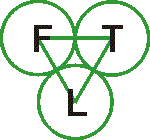Theory/Patents
TURBOSCRUBBER'S BREAKTHROUGH FLUIDISED BED GAS CLEANING TECHNOLOGY EXPLAINED:
Fluid Bed Theory
The new process patent related to the importance of generating turbulence by controlling the pressure gradient dP/dH across the bed and the role of the element shape defined by the factor y .
The control mechanism was shown as an equation;
![]() (1)
(1)
where, Ug = Superficial gas velocity
L/G = liquid to gas ratio
a,b = variable or system 'constants'
Up until that time the general equation for pressure gradient had been;
![]() (2)
(2)
With r = density ; subscripts: p = particle, g = gas, l = liquid
C = "variable" or system 'constants'
There
is a mathematical concern with equation (2) since![]() does not reduce to zero when Ug = 0.
does not reduce to zero when Ug = 0.
However it should be noted that these equations are only really considered valid from the point of full fludisation (about 10% higher in pressure gradient terms than incipient fluidisation). From the designers point of view it is this operational range and its limits which are of most importance.
The expanded form of equation (1) is shown in a more recent patent (10) produced by Davis & Ruff expanding the process to take all shapes into account and is as follows;
![]()
where ho = static bed height (non fluidised condition)
s = slip velocity (between element and gas)
y = shape factor
f = accentric or offset factor (difference between centre of gravity and mid point of tumbling axis or radius for spheres)
g = gravitational constant
The essential difference between spherical and non spherical shapes when used in a fluidised bed is the fact that both y and f have values of 1.0 for spheres ( a special case), whereas the numbers vary (0-1) for asymmetrical 'particles'. As another example Herr Ruff's 'ellipsoids' would have a reduced value for y and with f = 1.0 since its centre of gravity coincides with the centre of its long axis.
Thus by varying the size and exact shape of the element it is possible to control the system pressure gradient and consequently regulate the mass, heat or particulate transfer efficiency since.
i.e:
![]()
where Kog = overall mass transfer coefficient
The secret is to ensure that the elements are not merely lightly fluidised but to generate sufficient pressure gradient across the beds to violently tumble the elements around within a 'homogeneous' three phase mix. Whilst it is important to develop sufficient pressure gradient across the fluid bed the absolute value of the mass & heat transfer coefficients is in reality a function of bed turbulence and surface renewal rates (s) which are related to the rate of pressure loss in a specific way. That is to say that simply by increasing pressure gradient will not produce optimum design conditions. Having sufficient pressure gradient combined with the fastest tumbling rate or surface renewal will produce the best designs and avoid costly loss of energy in achieving the desired efficiency. However these conditions are unlikely to be met below a minimum pressure gradient value of around 1300Pa/m (1.5in/ft) due to the inexorable link between tumbling and the rate of pressure loss. In short a careful selection of element shape to achieve these optimum conditions is essential and then to ensure a good design or range of operating conditions for the gas-liquid contactor.
The work undertaken by FTL/OET has drawn heavily on and has effectively validated the pioneering work of Danckwerts (12) who showed that
where D = Diffusivity & s = surface renewal rate,
and in analogous fashion
where h = heat transfer coefficient & a = thermal diffusivity.
Thermal Diffusivity = K /Cpr
Where K = Conductivity
Cp = Specific Heat & r = density
Since the highly breakable symmetrical spherical balls cannot tumble around one or more axes it is only non symmetrical and sufficiently dense, tumbling elements that will generate the requisite pressure gradients , surface renewal rates, and hence mass transfer rates, that are well in excess of equivalent classical systems (i.e. fixed packing). Some recent work undertaken by Bochum University (published by Professor Billet in his book on packed towers (11)) compared light weight oblate spheroids to denser spherical balls (under controlled non 'gulf streaming' laboratory scale conditions) in a lightly fluidised regime (generally between 1,100 and 1,500 Pa/m) and not surprisingly, only showed more modest improvements over the spherical balls. Whilst the dense spheres generated high pressure gradients the lack of tumbling limited their efficiency and the lightly tumbled oblate spheroids suffered from operation at low pressure gradients due to their low density. This is not the industrial scale experience with well-agitated tumbling beds where efficient shapes & densities have been purposely selected and effectively used.
As a rule the onset of tumbling can be predicted using the equation
![]()
where A = ¦ (element size & bed density)
y = longest axis
r = 'radius' of centre of gravity
The graph clearly shows the rise in relative mass transfer coefficient against turbulence seen when ellipsoidal type shapes marketed as Turbofill® are fluidised. However It is the advance made with the Turboid® asymmetrical ovoidal elements and the newer TurboPak® asymmetrical hybrid shapes that really offers the clear advantages sought by engineers over the more classical scrubbing, stripping and distillation systems. By selecting shapes to reduce both the shape and the offset factors, bed and tower heights can be remarkably reduced over fixed beds. Since fluid bed towers can operate across a very wide range of gas and liquid velocities (turndown) there is considerable scope for reducing tower diameters (for new installations) or for retrofitting existing fixed pack and sieve plate units where improvements in absorption efficiency are sought or particulates or bottlenecking are problems. Despite higher pressure gradients tower pressure drop using the Turboids is on a par with the more energy efficient fixed packings and TurboPak® is even better thanks to the very low bed heights required. This is borne out by wide ranging test and full scale work undertaken by FTL/OET.
References
"Heat & Mass Transfer in a Turbulent Bed Contactor", W.J.M. Douglas, Chemical Engineering Progress Vol 60, No.7, July 1964
"Hydrodynamics of Turbulent Bed Contactors 1 & 2", H. Littman, G.V. Vunjak-Novakovic, D.V.Vukovic, Industrial Engineering Chemistry Research,Vol 26, No.5, 1987
"Gas & Liquid Hold Ups under the Countercurrent Flow of Air & Liquid", M. Kito, K. Tabei, K. Murata, Industrial Engineering Chemistry Process Design Developments, Vol 17, No.4,1978
"The Hydrodynamics of Gas-Liquid Contacting in Towers with Fluidised Packings", B.K. O'Neill, D.J. Nicklin, N.J. Morgan, L.S. Leung, Canadian Journal of Chemical Engineering, Vol 50, October 1972
"Fundamentals of Gas-Liquid-Solid Fluidization", K. Muroyama, L.S. Fan, AIChE Journal, Vol 31, No. 1, January 1985
S. Calvert, Chemical Engineering, Series 84, Vol 23, No. 133, 1977
"Gas-Liquid-Solid Fluidization Engineering", L.S. Fan, 1989
"Contact Elements for Separation from a Gas Stream of Particles and/or Gaseous Substances", German Patent, DE 3613151 A1, W. Ruff, October 1986
"Process for the Treatment of Gases, Ellipsoidal Packing & their Use", European Patent, EP 0456797,& U.S. Patent 5,376,165, H. P .Davis, W. Ruff, December 1990
"Mass or Energy Transfer Process Using Fluidized Bed", U.S. Patent 5,588,986, H. P. Davis, W. Ruff, December 1994
"Packed Towers in Processing & Environmental Technologies", R. Billet, 1995
"Gas-Liquid Reactions", P.V. Danckwerts, Cambridge University.


